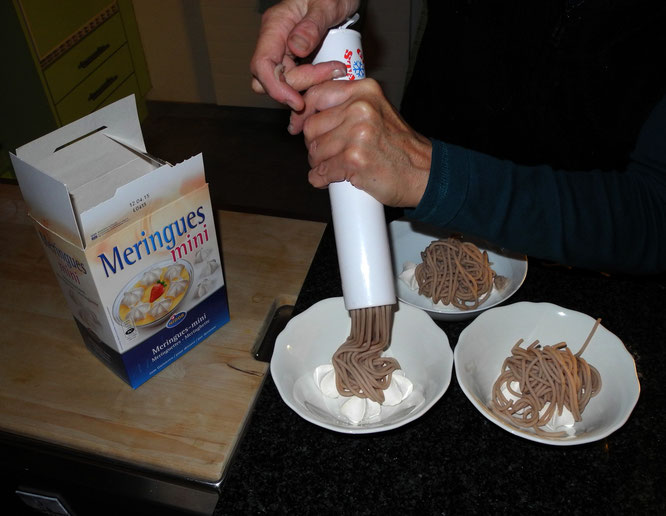chestnut - Kastanien
dict.cc englisch-deutsch chestnut
photos chestnut high resolution sroll, see more videos
kastanienland.ch swiss chestnut infos in german Googletransalter end of site!
Chestnuts are shiny brown nuts whose thick casing has long, sharp, needle-like spikes (burrs). There are usually two to four nuts per casing. Unlike other nuts, chestnuts have a high starch and water content but low protein and fat levels. They've never been as popular in British kitchens as in Continental ones, but they're a versatile and flavourful storecupboard ingredient. Chestnuts are available fresh, ground, dried, puréed or vacuum-packed.
Ground chestnut (chestnut flour) has a sweet strong flavour and a slightly pasty texture when cooked. Dried chestnuts lend a smoky flavour and robustness of character to soups or stews. There are two types of puréed chestnut: sweetened and unsweetened, which are used in sweet and savoury dishes respectively (the sweetened version is used in the classic Mont Blanc). Vacuum-packed chestnuts are of variable quality. The best are made from whole, unbroken nuts and work well in soups, stuffings, stews and sauces.
http://www.bbc.co.uk/food/chestnut




The chestnut group is a genus (Castanea) of eight or nine species of deciduous trees and shrubs in the beech family Fagaceae, native to temperate regions of the Northern Hemisphere. The name also refers to the edible nuts they produce.
The chestnut belongs to the same family as the oak and beech.
The four main species are commonly known as European, Chinese, Japanese and American chestnuts, some species called chinkapin or chinquapin:
- European species sweet chestnut (Castanea sativa) (also called "Spanish chestnut" in the US) is the only European species of chestnut, though was successfully introduced to the Himalayas and other temperate parts of Asia. Unrelated, but externally similar species of horse chestnut are abundant around Europe.
- Asiatic species Castanea crenata (Japanese chestnut), Castanea mollissima (Chinese chestnut), Castanea davidii (China), Castanea henryi (Chinese chinkapin, also called Henry's chestnut – China) and Castanea seguinii (also called Seguin's chestnut – China)
- American species These include Castanea dentata (American chestnut – Eastern states), Castanea pumila (American- or Allegheny chinkapin, also known as "dwarf chestnut" – Eastern states), Castanea alnifolia (Southern states), Castanea ashei (Southern states), Castanea floridana (Southern states) and Castanea paupispina (Southern states).
Chestnuts should not be confused with horse chestnuts (genus Aesculus), which are not related to Castanea and are named for producing nuts of similar appearance, but which are mildly poisonous to humans, nor should they be confused with water chestnut (family Cyperaceae), which are also unrelated to Castanea and are tubers of similar taste from an aquatic herbaceous plant.Other trees commonly mistaken for the chestnut tree are the chestnut oak (Quercus prinus) and the American beech (Fagus grandifolia).
Früher hatten die Kastanien im Wallis eine grosse Bedeutung als Lebensmittel. Heute muss die Regierung zur Erhaltung und Pflege der Kastanienwälder aufrufen.








